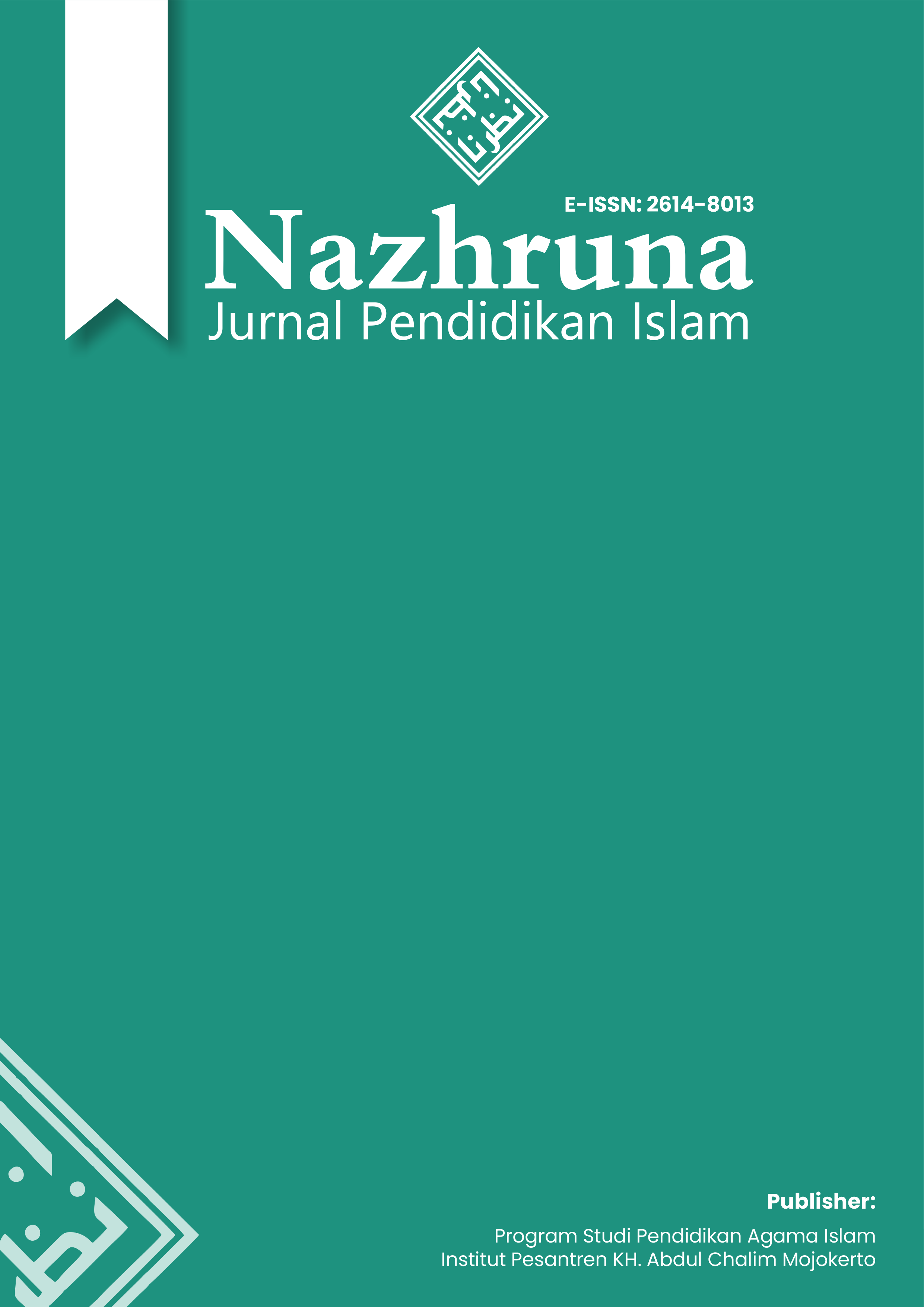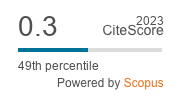The Role of Empathy, Self-Control, Self-Compassion, and School Climate in Madrasah Students for Predicting Cyberbullying in Yogyakarta
DOI:
https://doi.org/10.31538/nzh.v8i3.159Keywords:
Cyberbullying, empathy, self-control, school climate, self-compassionAbstract
This study aims to analyze the influence of empathy, self-control, school climate, and self-compassion on cyberbullying in Islamic schools. This study uses a quantitative methodology, using a questionnaire that measures cyberbullying, empathy, self-control, school climate, and self-compassion. The population in this study consisted of 1,314 students, with a sample of 605 students drawn from two schools. The sampling technique was simple random sampling, and the analysis used LISREL SEM. The results show that empathy, self-control, school climate, and self-compassion influence cyberbullying. Empathy hurts cyberbullying. Self-control hurts cyberbullying. School climate hurts cyberbullying. Self-compassion hurts cyberbullying. This study shows that more people need to be aware of the dangers of cyberbullying. This research also has implications for starting intervention programs, school rules, and more research on how empathy, self-control, school climate, and self-compassion can help prevent students from becoming victims of cyberbullying. This study suggests that empathy, self-control, self-compassion, and a favorable school climate can be protective factors against cyberbullying among madrasah students. These findings imply the need to develop intervention programs and school policies that support strengthening these aspects to prevent cyberbullying.
Downloads
References
Apologia, M. A., Mas’od, M. M., Masykuri, A., Hidayati, A., & Putra, V. E. P. (2024). Child-Friendly School Management: A Study of Ukhuwah Wathoniyah at Ma’arif Nahdlatul Ulama. Dirasah International Journal of Islamic Studies, 2(2), 106–119. https://doi.org/10.59373/drs.v2i2.28
Auriemma, V., Iorio, G., Roberti, G., & Morese, R. (2020). Cyberbullying and Empathy in the Age of Hyperconnection: An Interdisciplinary Approach. Frontiers in Sociology, 5. https://doi.org/10.3389/fsoc.2020.551881
Azwar, S. (2018). Reliabilitas dan validitas. Pustaka Pelajar.
Azwar, S. (2022). Metode Penelitian Psikologi Edisi II. Pustaka Pelajar.
Barlinska, J., Szuster, A., & Winiewski, M. (2018). Cyberbullying among adolescent bystanders: Role of affective versus cognitive empathy in increasing prosocial cyberbystander behavior. Frontiers in Psychology, 9(MAY). https://doi.org/10.3389/fpsyg.2018.00799
Barragán Martín, A. B., Molero Jurado, M. del M., Pérez-Fuentes, M. del C., Simón Márquez, M. del M., Martos Martínez, Á., Sisto, M., & Gázquez Linares, J. J. (2021). Study of cyberbullying among adolescents in recent years: A bibliometric analysis. International Journal of Environmental Research and Public Health, 18(6), 1–11. https://doi.org/10.3390/ijerph18063016
Bukhori, B., Nuriyyatiningrum, N. A. H., Zikrinawati, K., Liem, A., & Wahib, A. (2024). Determinant factors of cyberbullying behaviour among Indonesian adolescents. International Journal of Adolescence and Youth, 29(1). https://doi.org/10.1080/02673843.2023.2295442
Chen, D., Xu, B., & Chen, J. (2023). The association between domestic violence exposure and cyberbullying behavior among secondary school students. Frontiers in Psychiatry, 14. https://doi.org/10.3389/fpsyt.2023.1302477
Chen, Q., Tang, J., Zhu, Y., & Chan, K. L. (2024). The role of school climate on student disclosure of private information and cyberbullying: A comparison of regular and vocational school students in China. Frontiers in Public Health, 12. https://doi.org/10.3389/fpubh.2024.1336617
Chen, Q., & Zhu, Y. (2022). Cyberbullying victimisation among adolescents in China: Coping strategies and the role of self-compassion. Health and Social Care in the Community, 30(3), e677–e686. https://doi.org/10.1111/hsc.13438
Cho, S., & Rustu, D. (2020). Examining the impacts of low self-control and online lifestyles on cyberbullying perpetration among Korean adolescents: Using parallel process latent growth curve modeling. Children and Youth Services Review, 117(March), 105288. https://doi.org/10.1016/j.childyouth.2020.105288
Chu, X.-W., Fan, C.-Y., Liu, Q.-Q., & Zhou, Z.-K. (2018). Cyberbullying victimization and symptoms of depression and anxiety among Chinese adolescents: Examining hopelessness as a mediator and self-compassion as a moderator. Computers in Human Behavior, 86, 377–386. https://doi.org/10.1016/j.chb.2018.04.039
Denche-Zamorano, Á., Barrios-Fernandez, S., Galán-Arroyo, C., Sánchez-González, S., Montalva-Valenzuela, F., Castillo-Paredes, A., Rojo-Ramos, J., & Olivares, P. R. (2023). Science Mapping: A Bibliometric Analysis on Cyberbullying and the Psychological Dimensions of the Self. International Journal of Environmental Research and Public Health, 20(1). https://doi.org/10.3390/ijerph20010209
Dilmaç, B. (2017). The relationship between adolescents’ levels of hopelessness and cyberbullying: The role of values. Kuram ve Uygulamada Egitim Bilimleri, 17(4), 1119–1133. https://doi.org/10.12738/estp.2017.4.0610
Dzunnuroin, N. R., Julianingrum, P. P., & Rahmawati, I. (2023). The relationship between personality type and self-control with cyberbullying behavior in adolescents. 9, 6–12.
Erbicer, E. S., Ceylan, V., Yalçın, M. H., Erbiçer, S., Akın, E., Koçtürk, N., & Doğan, T. (2023). Cyberbullying among children and youth in Türkiye: A systematic review and meta-analysis. Journal of Pediatric Nursing, 73, 184–195. https://doi.org/10.1016/j.pedn.2023.09.003
Fang, Y., Yang, S., Zhao, B., & Huang, C. (2021). Cyberbullying detection in social networks using bi-gru with self-attention mechanism. Information (Switzerland), 12(4), 1–18. https://doi.org/10.3390/info12040171
Fekih-Romdhane, F., Malaeb, D., Farah, N., Stambouli, M., Cheour, M., Obeid, S., & Hallit, S. (2024). The relationship between cyberbullying perpetration/victimization and suicidal ideation in healthy young adults: The indirect effects of positive and negative psychotic experiences. BMC Psychiatry, 24(1), 1–13. https://doi.org/10.1186/s12888-024-05552-2
Ferdinand, A. (2014). Structural equation modeling dalam penelitian manajemen.
Ghozali, I., & Latan, H. (2015). Partial Least Squares, konsep, teknik dan aplikasi menggunakan program Smartpls 3.0 untuk penelitian empiris. Badan Penerbit UNDIP.
Ghozali, I., & Fuad, F. (2014). Structural Equation Modeling: Teori, Konsep, dan Aplikasi dengan Program Lisrel 9.10. Publisher: Badan Penerbit Universitas Diponegoro.
Graf, D., Yanagida, T., & Spiel, C. (2019). Through the magnifying glass: Empathy’s differential role in preventing and promoting traditional and cyberbullying. Computers in Human Behavior, 96, 186–195. https://doi.org/10.1016/j.chb.2019.02.007
Guo, S., Huang, N., Liu, X., Zhang, S., & Guo, J. (2024). Could school climate moderate the relationship between school bullying patterns and academic burnout in Chinese adolescents: A large cross-sectional study. Journal of Affective Disorders, 361, 146–156. https://doi.org/10.1016/j.jad.2024.06.024
Hizbullah, K., & Mulyati, R. (2022). The Role of Gratitude and Family Support on Psychological Well-Being of Mothers with Autistic Children. International Journal of Islamic Educational Psychology, 3(1), 2–18. https://doi.org/10.18196/ijiep.v3i1.13190
Hoareau, N., Bagès, C., & Guerrien, A. (2021). Cyberbullying, Self-control, Information, and Electronic Communication Technologies: Do Adolescents Know How to Exercise Self-control on the Internet? International Journal of Bullying Prevention. https://doi.org/10.1007/s42380-021-00099-2
Huang, J., Huebner, E. S., & Tian, L. (2022). Stability and Changes in Traditional and Cyberbullying Perpetration and Victimization in Childhood: The Predictive Role of Depressive Symptoms. Journal of Interpersonal Violence, 37(19–20), NP17300–NP17324. https://doi.org/10.1177/08862605211028004
Kaur, K., & Sandhu, D. (2024). Social and Emotional Discriminant Factors among Cyberbullying Perpetrators and Cyber Controls in a North Indian Adolescent Sample. In The Psychology of Cyberbullying (pp. 193–222).
Kollo, F. L., & Mahfud, T. (2024). Beware of cyberbullying! Evidence from high school students in Indonesia. International Journal of Evaluation and Research in Education , 13(3), 1465–1473. https://doi.org/10.11591/ijere.v13i3.26686
Lee, M.-B., Yeom, Y. O., Kim, M. S., Lee, Y., Kim, K. M., Kim, D. H., Lee, C. M., & Lim, M. H. (2023). Effects of school sandplay group therapy on children victims of cyberbullying. Medicine (United States), 102(14). https://doi.org/10.1097/MD.0000000000033469
Li, W. (2024). “Amusing ourselves to death”: Mechanisms in cyberbullying prompted by rumors and denigration amidst the COVID-19 pandemic in China. Technology in Society, 76. https://doi.org/10.1016/j.techsoc.2023.102446
Liang, H., Zhu, F., Li, X., Jiang, H., Zhang, Q., & Xiao, W. (2024). The Link Between Bullying Victimization, Maladjustment, Self-Control, and Bullying: A Comparison of Traditional and Cyberbullying Perpetrator. Youth and Society. https://doi.org/10.1177/0044118X241247213
M. Suud, F., & Na’imah, T. (2023). The effect of positive thinking training on academic stress of Muslim students in thesis writing: A quasi-experimental study. International Journal of Adolescence and Youth, 28(1). https://doi.org/10.1080/02673843.2023.2270051
Madkan, M., Mumtahana, L., & Ardianto, A. (2025). Implementation of Democratic Values in Islamic Education Learning: Perspectives and Approaches to Improve the Quality of Education. Adiluhung: Journal of Islamic Values and Civilization, 1(1), 1–15. https://doi.org/10.59373/adiluhung.v2i1.107
Maftuh, B., Dahliyana, A., Malihah, E., & Sartika, R. (2024). Does school climate matter in cyberbullying behaviour among high school student? A mediation and moderation analysis. Cakrawala Pendidikan, 43(1), 28–43. https://doi.org/10.21831/cp.v43i1.65213
Mang, L., Huang, N., Liu, X., Zhen, C., & Guo, J. (2023). The interaction effects of social support and four types of bullying on sleep quality in Chinese adolescents. Journal of Affective Disorders, 341, 119–127. https://doi.org/10.1016/j.jad.2023.08.092
Mateus Francisco, S., Costa Ferreira, P., Veiga Simão, A. M., & Salgado Pereira, N. (2024). Moral disengagement and empathy in cyberbullying: How they are related in reflection activities about a serious game. BMC Psychology, 12(1), 1–15. https://doi.org/10.1186/s40359-024-01582-3
Mohd Tajuddin, J. bt, Wan, P. M., & Muthukrishnan, P. (2020). Cyberbullying: Why Children do not tell? Annals of Tropical Medicine and Public Health, 23(13A). https://doi.org/10.36295/ASRO.2020.231330
Moon, J., & Mello, Z. R. (2021). Time among the taunted: The moderating effect of time perspective on bullying victimization and self-esteem in adolescents. Journal of Adolescence, 89, 170–182. https://doi.org/10.1016/j.adolescence.2021.05.002
Muhlis, A., Wardi, M. C., Baiquni, A., Septiadi, D. D., & Mansurnoor, I. A. (2025). The Demise of Sufi Values in Islamic Educational Institution: Bullying in Madurese Pesantrens. Ulumuna, 29(1), 71–101. https://doi.org/10.20414/ujis.v29i1.1071
Mukhopadhyay, D., Mishra, K., Mishra, K., & Tiwari, L. (2021). Cyber Bullying Detection Based on Twitter Dataset. In Lecture Notes in Networks and Systems (Vol. 141). Springer Singapore. https://doi.org/10.1007/978-981-15-7106-0_9
Peker, A., & Yildiz, M. (2021). Mediating Role of Self-Control in the Relationship between Aggressiveness and Cyber Bullying. Psychiatry and Behavioral Sciences, 11(1), 40. https://doi.org/10.5455/pbs.20210114051215
Periantalo, J. (2016). Penelitian Kuantitatif untuk Psikologi. Pustaka Pelajar.
Pusvitasari, R., & Zarkasyi, A. (2024). Holistic Approaches to Bullying Prevention: The Mediating Role of School Well-Being, Self-Management, and Empathy. At-Tadzkir: Islamic Education Journal, 3(2), 104–119. https://doi.org/10.59373/attadzkir.v3i2.63
Rahmawati, S., Setiyowati, A. J., & Eva, N. (2023). A Guidebook of Group Guidance Services with Role Play ContainsWelas Asih to Prevent Verbal Bullying. Munaddhomah: Jurnal Manajemen Pendidikan Islam, 4(4), 825–833. https://doi.org/10.31538/munaddhomah.v4i4.660
Shaikh, F. B., Rehman, M., Amin, A., Shamim, A., & Hashmani, M. A. (2021). Cyberbullying Behaviour: A Study of Undergraduate University Students. IEEE Access, 9, 92715–92734. https://doi.org/10.1109/ACCESS.2021.3086679
Strunk, K. K., & Mwavita, M. (2024). Design and Analysis in Quantitative Educational Research: Univariate Designs in SPSS: Second Edition. Routledge.
Sugiyono. (2015). Metode Penelitian Kombinasi (Mix Methods). Alfabeta.
Sugiyono. (2019). Metodologi Penelitian Kualitatif Kuantitatif Dan R&D. In Alfabeta.
Suud, F. M., & Salsabillah, W. T. (2024). The Impact of Islamic Resilience on Student Spirituality While Engaging in Digital Activities. Lecture Notes in Networks and Systems, 1013 LNNS, 483–492. https://doi.org/10.1007/978-981-97-3559-4_39
Tomkins, S., Getoor, L., Chen, Y., & Zhang, Y. (2018). A socio-linguistic model for cyberbullying detection. Proceedings of the 2018 IEEE/ACM International Conference on Advances in Social Networks Analysis and Mining, ASONAM 2018, 53–60. https://doi.org/10.1109/ASONAM.2018.8508294
Trana, R. E., Gomez, C. E., & Adler, R. F. (2021). Fighting Cyberbullying: An Analysis of Algorithms Used to Detect Harassing Text Found on YouTube. In Advances in Intelligent Systems and Computing: Vol. 1213 AISC. Springer International Publishing. https://doi.org/10.1007/978-3-030-51328-3_2
Utama, A. P., & Salim, H. (2024). Strategi Muhammadiyah Boarding School Klaten dalam Mengatasi Bullying di Kalangan Santri. Attadrib: Jurnal Pendidikan Guru Madrasah Ibtidaiyah, 7(2), 229–243. https://doi.org/10.54069/attadrib.v7i2.862
Utomo, K. D. M. (2022). Investigations of Cyber Bullying and Traditional Bullying in Adolescents on the Roles of Cognitive Empathy, Affective Empathy, and Age. International Journal of Instruction, 15(2), 937–950. https://doi.org/10.29333/iji.2022.15251a
Wang, K., Cui, Y., Hu, J., Zhang, Y., Zhao, W., & Feng, L. (2021). Cyberbullying Detection, Based on the FastText and Word Similarity Schemes. ACM Transactions on Asian and Low-Resource Language Information Processing, 20(1). https://doi.org/10.1145/3398191
Yu, C., Xie, Q., Lin, S., Liang, Y., Wang, G., Nie, Y., Wang, J., & Longobardi, C. (2020). Cyberbullying Victimization and Non-suicidal Self-Injurious Behavior Among Chinese Adolescents: School Engagement as a Mediator and Sensation Seeking as a Moderator. Frontiers in Psychology, 11. https://doi.org/10.3389/fpsyg.2020.572521
Zhalzabilah, Z., Hisbullah, H., & Firman, F. (2024). Pemanfaatan Aplikasi Android Belajar Membaca Untuk Meningkatkan Keterampilan Membaca Siswa. Attadrib: Jurnal Pendidikan Guru Madrasah Ibtidaiyah, 7(1), 52–62. https://doi.org/10.54069/attadrib.v7i1.723
Zhou, H., Wei, X., Jiang, H., Tuo, A., Lu, G., Liang, H., & Xiao, N. (2023). The link between exposure to violent media, normative beliefs about aggression, self-control, and aggression: A comparison of traditional and cyberbullying. Aggressive Behavior, 49(2), 165–171. https://doi.org/10.1002/ab.22057
Zych, I., Baldry, A. C., Farrington, D. P., & Llorent, V. J. (2019). Are children involved in cyberbullying low on empathy? A systematic review and meta-analysis of research on empathy versus different cyberbullying roles. Aggression and Violent Behavior, 45(2017), 83–97. https://doi.org/10.1016/j.avb.2018.03.004
Downloads
Published
How to Cite
Issue
Section
License
Copyright (c) 2025 Muniratul Husna, Partino Partino, Abd. Madjid, Fitriah M. Suud

This work is licensed under a Creative Commons Attribution-ShareAlike 4.0 International License.








